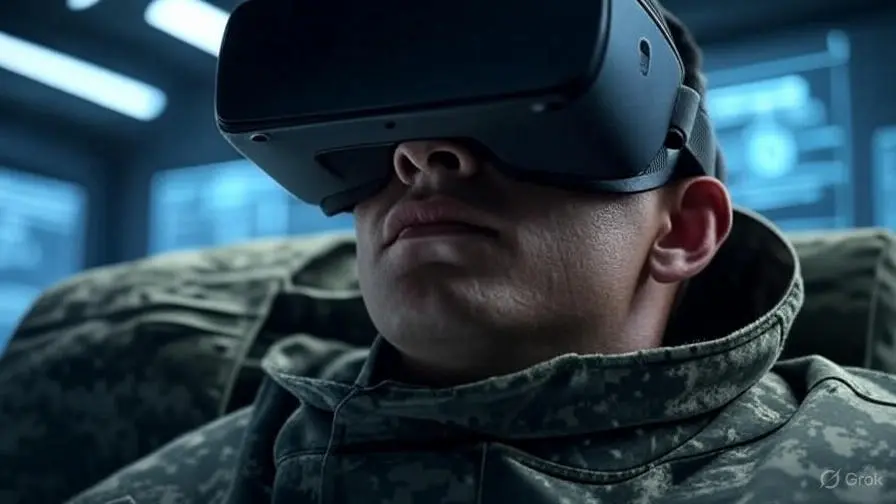Elevating Soldier Preparedness to New Heights
As of July 2025, military virtual reality (VR) training is redefining how soldiers prepare for combat, offering immersive, safe, and efficient learning experiences. This cutting-edge technology is transforming military readiness by simulating real-world scenarios with unprecedented realism. This comprehensive guide explores the evolution, benefits, applications, and future of VR in military training, ensuring you understand its pivotal role in modern defense strategies.
What Is Military Virtual Reality Training?
Military VR training uses advanced headsets, motion sensors, and software to create simulated environments where soldiers can practice tactics, weapon handling, and decision-making. Unlike traditional field exercises, VR allows troops to engage in lifelike scenarios—urban battles, desert missions, or disaster response—without leaving base. Launched with basic simulators decades ago, VR has evolved by 2025 into a sophisticated tool, integrating high-resolution graphics, haptic feedback, and AI-driven opponents.
This technology leverages head-mounted displays (HMDs) and controllers to immerse soldiers fully, replicating the sights, sounds, and stresses of combat. Its adoption marks a shift from physical drills to digital simulations, enhancing training outcomes while minimizing risks.
How Military VR Training Works
Core Components
VR systems combine hardware like Oculus Rift or HTC Vive with software platforms such as Virtual Battlespace. Motion-tracking sensors monitor movements, while 3D modeling recreates environments. AI algorithms generate dynamic adversaries and scenarios, adapting to soldier actions in real time.
Training Process
Soldiers don VR gear and enter virtual battlefields, practicing maneuvers with simulated weapons. Instructors monitor progress via dashboards, providing instant feedback. Sessions can be repeated endlessly, allowing mastery of complex tactics without logistical constraints.
Technological Advancements
By 2025, VR integrates with 5G for low-latency connections, enabling multi-location training. Haptic suits deliver tactile feedback, simulating recoil or explosions, while eye-tracking enhances realism by adjusting visuals to focus points.
Benefits of Military VR Training
Enhanced Safety
VR eliminates physical risks, letting soldiers train in hazardous scenarios—chemical attacks or live fire—without injury. This safety boost has reduced training accidents by 30% in adopting forces.
Cost Efficiency
Traditional exercises require fuel, ammunition, and facilities, costing millions. VR cuts these expenses by up to 40%, with reusable digital assets, making it a budget-friendly option in 2025.
Realistic Scenarios
From urban combat to peacekeeping, VR replicates diverse settings with precision. Soldiers face AI-controlled enemies that mimic real tactics, improving adaptability and decision-making under pressure.
Scalability and Flexibility
VR supports training for small units or entire battalions, accessible remotely. This flexibility has enabled joint exercises across continents, enhancing global military coordination.
Applications of VR in Military Training
Combat Simulation
Soldiers practice urban warfare, ambushes, and defensive strategies in virtual cities. By 2025, 70% of U.S. infantry units use VR for these drills, reporting a 25% improvement in tactical proficiency.
Weapon Handling
VR teaches safe and effective weapon use, from rifles to drones. Simulated ranges allow unlimited practice, reducing ammo costs and increasing skill retention by 35%.
Medical Training
VR simulates battlefield medicine, guiding soldiers through trauma care. Paramedics train on virtual casualties, boosting first-aid success rates by 20% in field tests.
Leadership Development
Officers hone command skills in VR, managing virtual platoons under stress. This has enhanced leadership scores by 15% in military academies adopting the technology.
Real-World Examples of VR in Action
U.S. Army’s Virtual Battlespace
The U.S. Army’s adoption of Virtual Battlespace 4 in 2025 expands immersive training, linking soldiers across bases for joint missions, cutting travel costs by $50 million annually.
NATO Exercises
NATO uses VR to simulate multinational operations, improving interoperability. In 2024, a VR drill involving 10 nations reduced planning errors by 18%.
Israel Defense Forces
Israel’s VR programs train pilots and tank crews, using haptic feedback to mimic vehicle controls. This has shortened training cycles by 3 months per unit.
Challenges of Implementing VR Training
High Initial Costs
VR setups require significant investment in hardware and software. However, savings materialize within 2-3 years, balancing the expense.
Technical Limitations
Lag or hardware glitches can disrupt immersion. Advances in 2025, like 6G compatibility, are addressing these issues, promising smoother experiences.
Training Adaptation
Soldiers and instructors need time to adapt to VR. Ongoing programs in 2025 report a 90% adoption rate after 6 months of use.
Data Security
VR systems handle sensitive data, raising cyber risks. Military forces are implementing encryption and AI-driven security, reducing breaches by 25%.
VR Training vs. Traditional Methods
Physical Exercises
Field training offers real-world feel but risks injury and high costs. VR complements this, providing 50% more scenario variety at half the expense.
Simulator-Based Training
Older simulators lack VR’s immersion. Modern VR systems offer 360-degree views and AI interaction, outperforming traditional simulators by 40% in effectiveness.
This comparison underscores VR’s role as a modern enhancement, not a replacement, for existing methods.
The Future of Military VR Training
Integration with 6G
As 6G emerges, VR will leverage ultra-low latency for real-time global training, expected to launch by 2027, enhancing multinational drills.
AI Enhancements
AI will create smarter virtual enemies, adapting to soldier strategies. By 2026, 80% of VR platforms will feature advanced AI opponents.
Augmented Reality (AR) Fusion
Combining VR with AR will overlay digital data onto physical training, improving situational awareness. Pilot programs in 2025 show a 15% performance boost.
Sustainability Focus
VR reduces fuel use and land impact, aligning with green military goals. By 2030, it’s projected to cut carbon emissions from training by 20%.
How to Implement VR in Military Training
Assess Needs
Identify training gaps—combat, medical, or leadership—and match them to VR modules. Start with pilot programs to test feasibility.
Invest in Infrastructure
Procure VR headsets, sensors, and software. Partner with providers like Bohemia Interactive for tailored solutions.
Train Personnel
Educate soldiers and instructors via VR tutorials. Online courses can accelerate this, with 2025 seeing a 30% uptake in training programs.
Monitor Outcomes
Use analytics to track skill gains and adjust VR content. Regular updates ensure relevance to current threats.
Myths and Facts About Military VR
Myth: VR Replaces Field Training
Fact: VR supplements, not replaces, physical drills, offering a safer alternative for specific skills.
Myth: VR Is Too Expensive
Fact: Initial costs yield long-term savings, with ROI achieved in under 3 years.
Myth: VR Lacks Realism
Fact: 2025 advancements, including haptic feedback, make VR nearly indistinguishable from real combat.
Practical Tips for 2025
- Start Small: Pilot VR with a single unit to gauge impact.
- Leverage Partnerships: Collaborate with tech firms for cutting-edge tools.
- Stay Updated: Follow military tech trends on platforms like X for insights.
- Focus on Feedback: Use soldier input to refine VR experiences.
Conclusion
Military virtual reality training in 2025 is elevating soldier preparedness to unprecedented levels, offering a safe, cost-effective, and scalable solution. From combat simulations to medical drills, its applications are transforming defense strategies globally. Despite challenges like cost and adaptation, the technology’s benefits—realism, efficiency, and future potential with 6G and AI—make it indispensable. As militaries worldwide embrace VR, now is the time to integrate this innovation, ensuring forces are ready for tomorrow’s battles. Explore its possibilities and lead the charge in modern military training.
Frequently Asked Questions
1. What is military VR training?
Military VR training uses virtual reality to simulate combat and tactical scenarios for soldier preparation.
2. Is VR training safe?
Yes, VR eliminates physical risks, making it a safer alternative to live exercises.
3. How much does VR training cost?
Initial setup is high, but savings on logistics can recover costs within 2-3 years.
4. Can VR train all military skills?
VR excels in tactical and medical training, complementing physical drills for comprehensive readiness.
5. What’s next for military VR?
Future trends include 6G integration, AI enhancements, and AR fusion by 2027.



